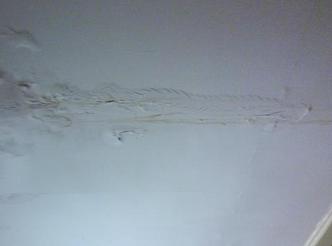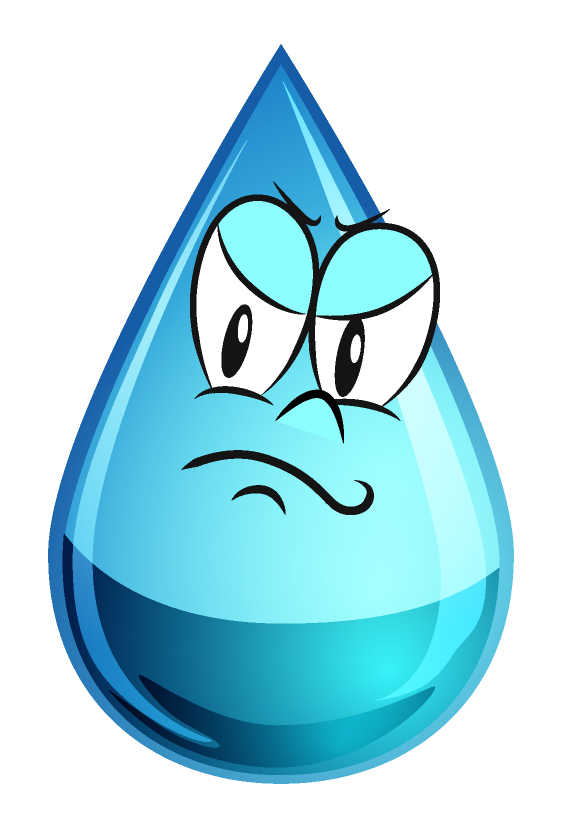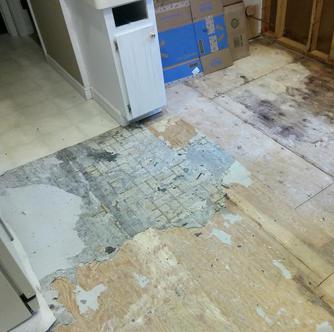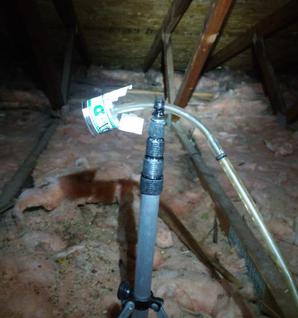Understanding the Water Damage Assessment and Restoration Process
Unforeseen incidents such as flooding, sewer backups, water intrusion from failing flashings and the like are a fact of life. They also seem to always happen at the worst time. These incidents are categorized by catastrophic event or accidents. Small persistent occurrences of building moisture can also lead to big problems over time.
By learning more about the basics of assessment of water damage and restoration, your anxieties can be alleviated as you understand how Tri-Tech and various trades and restoration professionals can address the various circumstances caused by water damage and get things back to normal. A savvy and handy building owner may even be qualified to correct some things themselves with some guidance!
The general goal of a mold assessment is to evaluate the extent of the mold (if any) and determine the physical conditions that could support mold growth. We have a number of different means of evaluation, to be used in order of importance including:
- Visual evaluation informed by years of experience
- Mold spore air and surface sampling
- Moisture meter survey
- Evaluation of first condensing surfaces (based on humidity and dewpoint)
Generally, bacteria testing is not performed. Mold is normally a greater concern and is less expensive and more reliably assessed by laboratory analyses. In unusual circumstances, bacterial water or surface testing and air testing of bacterial endotoxins can be performed. However, normally correcting the mold condition means that any associated bacterial growth has been mitigated.
Normally the focus of an investigation includes only the building structure itself, the mechanical system and major pieces of furniture. Large accumulations of resident possessions provide numerous additional food sources, mold spore/dust reservoirs and substrates for growth. The removal of possessions from the affected areas to the extent possible will facilitate a more accurate evaluation. In some circumstances, Tri-Tech may be able to assess the impact of mold or moisture to certain valuable or important possessions without concern for the building itself.
A secondary objective of the initial assessment is to answer the following questions:
• How bad is it? Can it be fixed by a homeowner or skilled building professional or does it require professional abatement?
How bad is it? Can it be fixed by a homeowner or skilled building professional or does it require professional abatement?
• What corrective actions can eliminate or mitigate the moisture source?
What corrective actions can eliminate or mitigate the moisture source?
Mold and moisture problems typically fall into one of two categories:
• An accident or continuing breakdown that results in a release of liquids into the home
An accident or continuing breakdown that results in a release of liquids into the home
• Chronic problems from condensation, elevated humidity and poor ventilation
Chronic problems from condensation, elevated humidity and poor ventilation
As guidance for answering the question “How bad is it?” and “Who can fix it?”, the Institute of Inspection, Cleaning and Restoration Standard Certification Guidelines can be used as a reference. Tri-Tech can provide a professional opinion on what Category of cleanup the project falls within:
Category 1: A Category 1 source originates from a water source (potable supply water, stormwater, greywater or drain lines with little or no sewage). This includes incidents such as broken water pipes, tub, toilet or sink overflows, aquarium or waterbed leaks, appliance malfunctions, and intrusion of rain or melting ice or snow. These incidents typically can be cleaned up by a homeowner or contractor with little skill or risk, particularly if started with 24 hours of the incident. These projects typically do not require demolition or substantial removal of building finish. Based on a general industry guideline (NYCDH) , these projects will normally include all impacts smaller than 10 square feet.
Category 2: A Category 2 source contains contaminated liquids and has the potential to cause illness or allergic reactions if contacted by sensitive individuals. Some personal protective equipment should be used for these cleanups. Category 2 examples include incidents where sewage or dirty water is present. Category 2 can also result from no action being performed to cleanup a Category 1 source, which has caused substantial mold to grow. This source is categorized as something a restoration contractor typically handles but a homeowner or trades contractor could complete the work with precautions and some basic skills or training. Typically some building finish removal or demolition will be required. Containment may be used for general dust control. Commercials biocides are typically not used or required. Household-grade sanitizers and methods of sealing with stainkill products can be utilized where there is doubt that the mold has been removed from the substrate (e.g. areas that are hard to reach). Duct cleaning is not typically required unless their evidence of direct impact (flood water discharged to the vents). Based on a general industry guideline, this will include one or more areas affecting more than 10 square feet but less than 100 square feet.
Category 3: A Category 3 water source is typically grossly contaminated and can contain pathogenic, toxigenic/mycotoxic or other harmful substances that could cause significant adverse reactions or infections to humans if contacted. A large Category 2 source could degrade to a Category 3 if the water source was large enough and temperatures or other conditions were sufficient to sustain substantial microbiological growth. A Category 3 source could also include Category 2 conditions where another contaminant consideration is involved (e.g. asbestos, leaked chemicals or trauma-related body fluids). Examples can include severe sewage backups or basement allowed to remain wet or flooded for a long period of time. These severe conditions are best handled only by professional restoration or mold abatement contractors and will include disinfection with commercial-grade biocides. These projects will typically include building material removal and demolition unless all surfaces are impervious (e.g. walls and concrete floors). Based on a general industry rule of thumb, one or more areas over 100 square feet of significant impact will typically involve a Category 3 condition.
A Category 3 condition will often require HVAC shut-down during cleanup and duct cleaning or replacement of the ducts afterwards due to the contamination of these systems. A Category 3 cleanup might involve related lesser Category conditions elsewhere (e.g. a severely flooded basement may cause a Category 1 or 2 condition of mold from elevated humidity or condensation on the first floor).
A typical project will consist of an evaluation of the extent of the mold, possible or known causes and recommendations. In some circumstances, the opinion of an additional building trades professional will be needed, such as in the following examples:
- Does the attic need additional ventilation to meet code requirements and limit mold growth?
- Does the foundation require additional waterproofing controls or improved drainage?
- Does the crawlspace require additional ventilation, lining or sealing?
Tri-Tech will advise on the qualifications and precautions for any cleanup, restoration or preventative measures. Upon completion, a Mold Clearance is typically performed based on the following guidance:
Category 1: A mold clearance is typically not dictated except for very cautious homeowners/building owners or those who are highly allergic or have immune-compromised occupants.
Category 2: A mold clearance may be performed. For smaller projects, the contractor may elect to check and document their own work with moisture and humidity meters. For larger projects, a mold clearance is typically performed, particularly if there is immediate re-occupancy. A mold clearance is not typically performed for vacant homes under Category 2 unless the owner is seeking to show proof of cleanup to an incoming resident or new owner. A homeowner or occupant is discouraged from occupying the affected areas but is not absolutely restricted from doing so prior to the clearance. Air scrubbers may be used during the project but are not required to run until final clearance is achieved.
The clearance requirement for Category 2 is also informed by the number of occupants in a building. The greater numbers of persons present indicate the greater likelihood that a mold-sensitive individual will potentially be exposed. Conversely, an infrequently occupied area such as an attic or garage would typically not require a clearance. The speed of re-occupancy is also a consideration as mold will naturally dissipate through ventilation and air changes over time.
Category 3: A mold clearance is required and will often be budgeted and paid for by the restoration contractor for their liability protection. Containment barriers will be in place preventing homeowner access until clearance is achieved or temporary accommodations may be required outside the home. Clearance testing of other contaminants may be required (e.g. asbestos). A homeowner may also decide to retain an independent inspector to assure that there is no conflict of interest and the results are objective and conclusive. Often air scrubbers with negative air pressure (exhausted outside the containment) are utilized and the standards for clearance are more stringent. The clearance threshold should be agreed upon before testing and will often require that no “water loss indicator” or “black mold types” be detected in the air samples.
The process of having your home or business assessed and then remediated of mold and water damage will understandly be a time of anxiety and uncertainty. However, you should be assured that a large majority of projects go very smoothly and quickly thanks to the experience, technology and training of the professionals in the restoration industry!
Tri-Tech has worked for or with industry restoration professionals including:
Is this cosmetic water damage or evidence of something more severe? A mold professional can tell you.
Kitchen cleanups often result in the testing and removal of multiple layers of flooring and subflooring
Mold clearance air sampling involves drawing a known sample of air through a sample cassette containing a microscope slide with a sticky substance that traps particulate
Understanding the Mold Clearance Process
A mold clearance will typically consist of a visual inspection and the collection of mold spore air samples. A visual inspection will confirm that the work was completed in a satisfactory manner. Mold spore air sample data are collected and the results are compared with normal household background conditions. Independent moisture meter measurements or infra-red thermal camera scans may also be used in some circumstances to verify dryness. If mold spore levels remain high, the abatement contractor would be directed to additional air scrubbing and cleaning activities to reduce mold spore levels.




